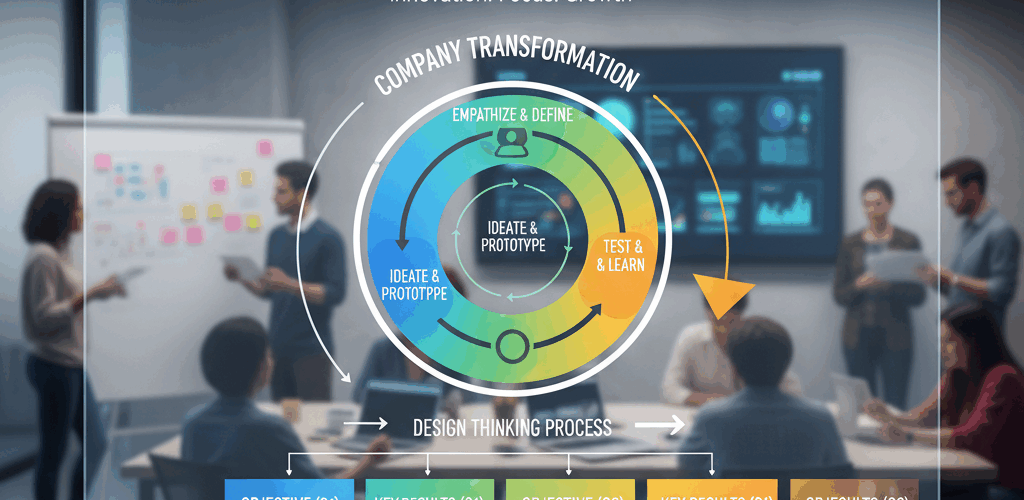EN
DE
NL
Welcome to the Adaptive Strategy Operating System (ASOS).
Are you tired of scaling frameworks (looking at you, SAFe, LeSS, etc.) turning your transformation into a bureaucratic, process-heavy nightmare?
I believe that strategy is not a static contract or a document you hand down. It’s a living product that must adapt to human needs. We’ve stopped worshipping frameworks and built an alternative that is lighter, more resilient, and fundamentally more human.
The Adaptive Strategy Operating System (ASOS) is a post-framework approach that combines the Empathy of Design Thinking, the Flow of Kanban, and the Alignment of Objectives and Key Results (OKRs).
The 4 Core Principles of ASOS
| Principle | What we do | The Outcome |
| 1. Meaning Before Mechanics | We start with Empathy (Design Thinking), not with processes, roles, or tools. Change is a response to human experience. | Higher acceptance, better energy, and significantly lower resistance. |
| 2. Adaptive Strategy in Action | Strategy (our Objectives) is treated like a product—a dynamic hypothesis—that evolves organically through learning. | Connects structure (Kanban) with empathy (Design Thinking) for continuous relevance. |
| 3. Joint Sense-Making | Reviews are transformed from management reporting events into a shared space of learning where leaders and teams jointly interpret evidence. | Shifts leadership’s role from rating performance to participating in discovery. (Servant Leadership 2.0). |
| 4. Post-Framework Mindset | We use established tools (DT, OKR, Kanban) as flexible building blocks—not as a religion. We build our own OS, calibrated to our reality. | Freedom and flexibility to integrate, adapt, or drop tools as needed. |
How ASOS Works: Empathy-Driven Governance
We align the WHY & WHEN of change (Design Thinking) with the HOW (Kanban).
1. The Design Thinking Trigger
Change is human-driven, not schedule-driven. New Sub-Objectives are only proposed when new insights (frustrations, wishes, or opportunities) from users or employees trigger a need for strategic realignment.
2. Evolving Objectives (Kanban Flow)
Our strategy is visualized as a flow system, ensuring transparency and continuous relevance.
| Flow State | Meaning | Action |
| Proposed | New Objective identified from research/Empathy Trigger. | Discuss, prioritize, and define in a joint management/team review. |
| Active | Objective is currently in focus; linked to active Key Results. | Teams collect evidence and review progress regularly. |
| Retired | Objective achieved or no longer relevant. | Archived with documentation of key learnings for the organization. |
This approach is not anti-Agile. It is simply better calibrated to the human reality in which people actually work. It creates stability through clear objectives and flexibility through empathy-driven evolution.
AI as a Transformation Partner (DTx / ASOS Integration)
Purpose
AI doesn’t replace leadership — it augments awareness.
AI doesn’t help with ‘doing’, but with seeing, understanding and deciding.
Roles of AI inside the System
Area AI contribution Benefit
Empathy & Insights GPT-supported evaluation of interviews, surveys, feedback loops Recognise patterns faster, reduce bias
Evidence Review Automated summary of data, trends, outcomes Basis for objective decisions
Learning Loop Creation of learning narratives from team experiences (‘What did we learn?’) Knowledge flow instead of knowledge silos
Communication & Clarity AI assistants formulate meeting summaries, FAQs, change news Transparent communication without overhead
Experiment Design AI helps with hypothesis formulation, scenario simulation, impact estimation Faster, more informed decisions
Governance Support AI monitors OKRs, recognises patterns & bottlenecks Early warning system instead of micromanagement
Principles for meaningful AI use
- Augment, don’t automate – AI supports people, it doesn’t replace them.
- Transparency first – Every AI decision is explainable.
- Ethical by design – Data protection, fairness and cultural sensitivity are non-negotiable.
- Human feedback loop – AI provides suggestions, humans validate them.
- Learning over judging – AI is a mirror, not a judge.
Example
- After each review, the FutureOrg AI Navigator automatically generates a learning summary (‘Top 3 Insights, Emerging Risks, Recommended Actions’).
- Teams review the suggestions, add context and adopt what makes sense.
- Management sees the big picture without having to create 20 PowerPoint presentations.
Result
AI thus becomes part of the operational nervous system of your framework – not an extra tool, but the co-pilot in the learning process.
You and your team remain the decision-makers,
but you make decisions at a completely different altitude: faster, more informed, more human.
What’s your operating system for change?
